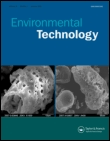
ENVIRONMENTAL TECHNOLOGY
Scope & Guideline
Pioneering Research for a Sustainable Future
Introduction
Aims and Scopes
- Wastewater Treatment Technologies:
Research on advanced treatment processes for municipal and industrial wastewater, including biological, chemical, and physical methods to enhance pollutant removal efficiency. - Pollution Remediation and Control:
Studies focused on the degradation and removal of pollutants from various environments, utilizing innovative methods such as photocatalysis, electrochemical processes, and bioremediation. - Resource Recovery and Recycling:
Exploration of technologies for recovering valuable resources from waste materials, including metals, nutrients, and energy, to promote circular economy practices. - Environmental Impact Assessment:
Research assessing the environmental impacts of various technologies and practices, including life cycle assessments and risk evaluations related to pollutants and waste management. - Sustainable Materials and Processes:
Development and application of new materials and processes that are environmentally friendly, such as biodegradable materials, green chemistry, and bioproducts.
Trending and Emerging
- Advanced Oxidation Processes (AOPs):
There is an increasing focus on advanced oxidation processes for the degradation of persistent organic pollutants, reflecting advancements in photocatalysis and electrochemical methods. - Microbial Fuel Cells and Bioelectricity:
Research on microbial fuel cells and their applications for wastewater treatment and energy recovery is gaining momentum, as scientists explore sustainable energy production from organic waste. - Nanotechnology in Environmental Remediation:
The application of nanotechnology for pollutant removal and environmental remediation is emerging as a significant trend, with studies investigating the use of nanomaterials for enhanced adsorption and degradation. - Integrated Waste Management Systems:
There is a growing emphasis on integrated approaches to waste management that combine multiple treatment technologies, reflecting a trend towards holistic solutions for waste and resource recovery. - Climate Change Mitigation Strategies:
Research focusing on technologies and practices aimed at mitigating climate change impacts, such as carbon capture and storage, is increasingly prominent in current publications.
Declining or Waning
- Traditional Chemical Treatment Methods:
There has been a noticeable decrease in the publication of papers focusing solely on conventional chemical treatment methods, as researchers increasingly explore more innovative and sustainable alternatives. - Basic Environmental Monitoring:
Research focused on basic environmental monitoring techniques has waned, with a shift towards more integrated and advanced monitoring systems that leverage technology and data analytics. - Single Pollutant Studies:
Studies examining the effects of single pollutants in isolation are less common, as there is a growing emphasis on understanding the interactions and cumulative effects of multiple pollutants. - End-of-Pipe Solutions:
There is a declining interest in traditional end-of-pipe solutions for pollution control, as the focus shifts towards preventive measures and sustainable practices that minimize waste generation. - Laboratory-Scale Studies:
Research presenting results solely from laboratory-scale studies is declining, as there is a stronger emphasis on pilot-scale and field studies that demonstrate practical applications.
Similar Journals
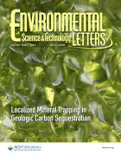
Environmental Science & Technology Letters
Leading the charge in ecological innovation and sustainability.Environmental Science & Technology Letters, published by the American Chemical Society, stands as a premier journal in the realm of environmental science and technology, focusing on pivotal studies that address pressing environmental challenges. With an impressive Q1 ranking in multiple categories including Ecology, Environmental Chemistry, and Pollution, this journal maintains a position of excellence within its field, achieving Scopus ranks that place it in the top percentile of Environmental Science disciplines. Although not open access, Environmental Science & Technology Letters offers vital insights and cutting-edge research that contribute significantly to the understanding and management of environmental issues. The journal’s objectives include disseminating ground-breaking findings and promoting discussions that lead to sustainable solutions. With convergence from 2013 to 2024, it continues to serve as an essential resource for researchers, professionals, and students committed to advancing knowledge and innovation in environmental science.

ENVIRONMENTAL ENGINEERING SCIENCE
Catalyzing change through cutting-edge environmental research.ENVIRONMENTAL ENGINEERING SCIENCE is a leading journal published by MARY ANN LIEBERT, INC that provides a platform for pioneering research in the fields of environmental chemistry, pollution control, and waste management. With an ISSN of 1092-8758 and an E-ISSN of 1557-9018, this peer-reviewed journal aims to disseminate high-quality scientific studies that address critical environmental challenges. As evidenced by its 2023 category quartile rankings, it holds a notable position at Q3 in Environmental Chemistry and Pollution and Q2 in Waste Management and Disposal, highlighting its relevance and impact in these domains. Spanning over two decades from 1997 to 2024, the journal is dedicated to fostering innovations and promoting rigorous scholarship that can contribute significantly to sustainable environmental practices globally. Authors and researchers are encouraged to engage with this essential resource, which offers Open Access options to enhance the visibility and reach of their work. For those interested in advancing their understanding and practice within the environmental sciences, ENVIRONMENTAL ENGINEERING SCIENCE is an indispensable journal to consider.
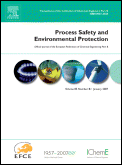
PROCESS SAFETY AND ENVIRONMENTAL PROTECTION
Unraveling the complexities of risk and reliability in engineering.PROCESS SAFETY AND ENVIRONMENTAL PROTECTION, published by Elsevier, is a premier academic journal dedicated to advancing the fields of chemical engineering, environmental science, and safety management. With an impressive impact factor, this esteemed journal undergoes a meticulous peer-review process and serves as a vital platform for researchers, professionals, and students seeking to disseminate cutting-edge research and innovative practices. Submissions are welcome in a wide scope of topics related to safety, risk, reliability, and environmental engineering, demonstrating its influence as a Q1 journal across multiple categories, including Environmental Chemistry and Safety, Risk, Reliability and Quality. By providing a rigorous analysis of current challenges and solutions in the domain since its inception in 1990, it continues to foster interdisciplinary collaboration and practical applications in the United Kingdom and beyond. With the journal not currently offering Open Access options, subscribers gain exclusive access to pivotal insights that shape industry standards and drive advancements in sustainable practices.

ACS ES&T Engineering
Empowering Researchers to Tackle Today's Engineering Challenges.ACS ES&T Engineering, published by the American Chemical Society, stands as a leading journal in the realm of Chemical Engineering, Environmental Chemistry, and related fields, with a notable Impact Factor indicative of its scholarly influence. Emerging from 2021 with a vision to address contemporary challenges in engineering and environmental health, this Journal not only covers critical studies in Chemical Engineering but also excels in areas such as Process Chemistry and Technology, aligning with its Q1 status across several categories in 2023. With exceptional rankings in Scopus, including a percentile rank in the 90th for Chemical Health and Safety, it offers a significant platform for researchers, educators, and practitioners to disseminate innovative research and practices. Although the journal maintains a subscription model, its commitment to rigorous peer review and high-quality content ensures that readers gain access to pivotal findings essential for advancing knowledge and practice in a rapidly evolving scientific landscape. For those dedicated to tackling global engineering challenges, ACS ES&T Engineering is an invaluable resource.

Environmental Science-Advances
Advancing knowledge for a sustainable future.Environmental Science-Advances, published by the esteemed Royal Society of Chemistry, is a pioneering open-access journal dedicated to advancing the field of environmental sciences. Having commenced publication in 2022, this journal serves as a vital platform for the rapid dissemination of high-quality research covering a broad scope, including environmental chemistry, pollution management, water science and technology, and environmental engineering. With its commitment to open access, it ensures that vital environmental research is freely available to researchers, professionals, and students worldwide, thus fostering collaboration and innovation in addressing pressing environmental challenges. Currently, the journal is ranked in the Q2 and Q3 quartiles across various categories such as Environmental Engineering and Water Science, indicating its growing influence within the academic community. With the global imperative for sustainable environmental solutions, Environmental Science-Advances is positioned to become an invaluable resource for those dedicated to the study and solution of environmental issues.
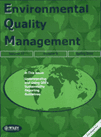
ENVIRONMENTAL QUALITY MANAGEMENT
Elevating Standards in Environmental Research and ManagementENVIRONMENTAL QUALITY MANAGEMENT is a respected journal published by WILEY, focusing on interdisciplinary studies that merge environmental science with public health, management, policy, and law. Since its inception in 1991, this journal has provided a platform for researchers and practitioners to share innovative insights and advancements in understanding environmental quality and its impacts on human health and the ecosystem. With an ISSN of 1088-1913 and an E-ISSN of 1520-6483, it holds a significant position in the academic community, evidenced by its presence in the Q3 quartile across several categories, including Management, Monitoring, Policy and Law, as well as Pollution and Waste Management. Although it is not an open-access journal, it continues to be a vital resource for those in the environmental sector, offering robust evaluations and discussions that advance knowledge and foster improved practices. With Scopus rankings demonstrating its relevance among other titles in the field, ENVIRONMENTAL QUALITY MANAGEMENT plays a crucial role in shaping discourse and informing policy in an increasingly vital area of study.
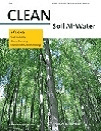
CLEAN-Soil Air Water
Championing Open Access for Environmental AwarenessCLEAN-Soil Air Water, an esteemed journal published by Wiley, serves as a vital platform for disseminating research in the fields of environmental chemistry, pollution, and water science and technology. Operating under an Open Access model, it embraces the principles of knowledge sharing, making significant research findings readily accessible to a global audience. With an ISSN of 1863-0650 and an E-ISSN of 1863-0669, the journal has demonstrated its importance in the academic community, reflected in its Scopus rankings within the top quartiles of its categories. Established in 2007 and continuing through to 2024, CLEAN-Soil Air Water offers researchers, professionals, and students an opportunity to explore innovative studies that address pressing environmental challenges, facilitating an exchange of novel ideas and techniques essential for sustainable development. With a publication footprint in Germany and a growing international reputation, this journal is an invaluable resource for those dedicated to advancing the science and practices of environmental stewardship.

Journal of Environmental Health Science and Engineering
Transforming research into actionable insights for a healthier planet.Journal of Environmental Health Science and Engineering, published by Springer, stands at the forefront of scholarly research in environmental health and engineering. With an impressive E-ISSN of 2052-336X and a significant impact factor reflected in its Q2 quartile rankings across various essential categories—including Applied Microbiology, Environmental Engineering, and Public Health—the journal serves as a vital platform for disseminating high-quality research from 2012 to 2024. Its rankings in fields such as Environmental Science and Waste Management position it as a distinguished resource for professionals and academics aiming to advance their understanding of contemporary environmental challenges. As an open-access journal based in Switzerland, it champions accessibility and collaboration, allowing researchers to share insights that influence policy and practical applications in environmental health. The journal's commitment to fostering innovative research makes it indispensable for those dedicated to enhancing the intersection of environmental science and public health.

Frontiers of Environmental Science & Engineering
Advancing sustainable solutions for a resilient future.Frontiers of Environmental Science & Engineering is a premier journal published by HIGHER EDUCATION PRESS that stands at the forefront of interdisciplinary research in environmental science and engineering. Established in 2013 and converging its scope through 2024, this journal has swiftly ascended to a notable Q1 category in the Environmental Science (Miscellaneous) segment, highlighting its remarkable impact and relevance. With a Scopus ranking of 27 out of 233 in its field, placing it within the top 88th percentile, it serves as a crucial platform for disseminating cutting-edge research, innovative methodologies, and pressing environmental concerns. Researchers, professionals, and students alike will find valuable insights and opportunities for collaboration within its pages. While the journal operates under a subscription model, its commitment to advancing the field makes it an essential resource for those dedicated to addressing the world's environmental challenges, fostering sustainable practices, and pioneering engineering solutions.

Environmental Sciences Europe
Unlocking access to vital environmental insights.Environmental Sciences Europe is a leading peer-reviewed journal published by SPRINGER, dedicated to advancing research in the field of environmental science, with a specific focus on pollution and its mitigation. Since its transition to Open Access in 2011, the journal has been committed to disseminating high-quality research without barriers, thereby ensuring that critical knowledge is freely accessible to researchers, practitioners, and policymakers around the globe. Based in Germany and with a commendable Q1 ranking in Pollution for 2023, the journal stands out in the Scopus rankings, occupying the 23rd position out of 167 in its category, reflecting its significant impact in shaping environmental discourse. With a convergence of global research efforts projected until 2024, Environmental Sciences Europe aims to provide a vital platform for scholarly communication and collaboration, ultimately contributing to sustainable solutions for pressing environmental challenges.